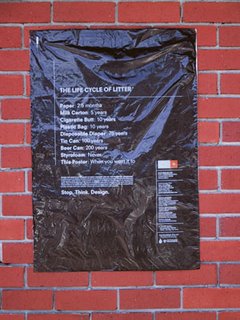This was an exciting project to work on, mainly because when you're designing for a design festival, you can really set the cat on fire and bring out the juggling elephants. The campaign was based around the central thought of "Stop. Think. Design." or the idea that designers need to take responsibility for what they create. Hence, in the print campaign, we named and shamed, in a sense, the designers responsible for the AK47, Whites Only Signs, The Florida Ballot and more.
The poster itself is an example of design with a conscious, the plastic bag it's printed on is preprogrammed to degraded over time.

Design Indaba 8: Stop. Think. Design.
As design becomes an increasingly respected tool, designers walk the inevitable tightrope of power and its corollary: responsibility. While for previous Design Indaba speaker, Ross Lovegrove, this could mean the intricate possibilities of maximising the use of a solar powered car, fellow designer, Neville Brody broaches the subject: Can design feed people? Indeed, while a TV commercial's 30 seconds of fame may be fleeting, and a print ad a momentary distraction, a work of design, argues The Jupiter Drawing Room Cape Town, may have more lasting implications.
With the potential longevity of design as a starting point, Jupiter designers have developed a campaign for Design Indaba 8 with the following logic: Stop. Think. Design. "The campaign is about realising the potential and power of design," says designer Carla Kreuser. "It hopes to explore new possibilities rather than be a preacher of doomsday messages. We're looking at design as something that goes beyond a 9 to 5 desk job, as something both powerful and empowering." Adds Jupiter Design Writer, Iain Thomas, "Of all the media, elements of design like a logo or a product's packaging are designed to endure, and we hope to create a sense of the social impact of that extended lifespan, and the responsibility which must accompany it."
How better to in investigate responsible design than to venture a gaze at its antithesis? Designs like the infamously misleading Bush-Gore Florida ballot and the Apartheid era's officious "White's Only" signs find new life in the Design Indaba 8's print campaign. Designers and the institutions responsible for these "artworks" are acknowledged beside their creations to emphasise designers' intricate relationship with the society in which they operate, and their responsibility (or lack thereof) to that society.
Further tribute to the functionality of design comes through the Design Indaba 8 poster, perhaps the most ingenious element of the campaign. "Where a traditional poster lives as a piece of cardboard attached to a wall and is eventually relegated to waste, the DI8 poster is a perfect marriage of function and form. Created from oxo-biodegradable plastic, the bag contains an additive, which allows it to decompose once exposed to the environment until all that remains is simply water, humus and carbon dioxide.
The poster reveals "The Life Cycle of Litter", and details the lifespan of commonly discarded items. While a tin can may last for a century, the poster will cease to exist "When you want it to." "We wanted to illustrate the concept through the design of the poster, to positively explore the choices people have as designers," says Thomas. "Certain designs may be functional or beautiful enough to develop a second life in their original form. However, if a design cannot function beyond its initial purpose, then at least prevent it from being another item of discarded waste."
Sent as a mailer inside the biodegradable poster is the Design Indaba brochure. Once again, it becomes apparent how, in Thomas' words, "One person's design becomes another's rubbish." The brochure's jacket cover is the product of hours of dustbin-digging reformed into a 2D design graveyard. Further occurrences of design's unsuccessful second life feature inside, with a broken heel illustrating a wasted shoe in the fashion, jewellery and trends section, and a house skewed by a hurricane introducing the importance of architecture. Says Kreuser of the dilapidated house, "When we found that image, we noticed that while some houses had survived the hurricane, others completely collapsed. Another example of imperfect design becoming wasteage."
The focus on functionality is becoming increasingly relevant in the design community. "Particularly in South Africa, where we have limited resources", says Kreuser, "design needs to have a social conscience. It's not necessarily about change on a major level it can mean something as simple as designing a chair which is more ergonomic, more comfortable, more suited to its purpose." The designers Design Indaba 8 is attracting are impassioned and compassionate people who are concerned with design as an improving tool. "We live in an age which is aware of its circumstances and has a desire to be responsible. The Stop. Think. Design. campaign is the obvious next step," says Thomas.
Issued by: Kate Kilalea









No comments:
Post a Comment